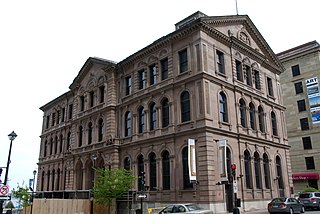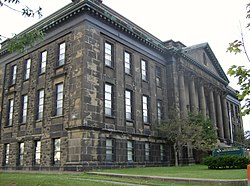
Fredericton is the capital city of the Canadian province of New Brunswick. The city is situated in the west-central portion of the province along the Saint John River, also known by its Indigenous name of Wolastoq, which flows west to east as it bisects the city. The river is the dominant natural feature of the area. One of the main urban centres in New Brunswick, the city had a population of 63,116 and a metropolitan population of 108,610 in the 2021 Canadian census. It is the third-largest city in the province after Moncton and Saint John.

Saint John is a seaport city located on the Bay of Fundy in the province of New Brunswick, Canada. It is Canada's oldest incorporated city, established by royal charter on May 18, 1785, during the reign of George III. The port is Canada's third-largest by tonnage with a cargo base that includes dry and liquid bulk, break bulk, containers, and cruise. The city has a strong industrial base, including oil refining and manufacturing, matched with finance and tourism sectors and research institutions such as the New Brunswick Museum and the University of New Brunswick.

Bathurst is a city in northern New Brunswick with a population of 12,157 and the 4th largest metropolitan area in New Brunswick as defined by Census Canada with a population of 31,387 as of 2021. The City of Bathurst overlooks Nepisiguit Bay, part of Chaleur Bay and is at the estuary of the Nepisiguit River.

Abraham Pineo Gesner, ONB was a Nova Scotian and New Brunswickan physician and geologist who invented kerosene. Gesner was born in Cornwallis, Nova Scotia and lived much of his life in Saint John, New Brunswick. He died in Halifax, Nova Scotia. He was an influential figure in the development of the study of Canadian geology and natural history.

Canada has a large domestic and foreign tourism industry. The second largest country in the world, Canada's wide geographical variety is a significant tourist attractor. Much of the country's tourism is centred in the following regions: Toronto, Montreal, Quebec City, Vancouver/Whistler, Niagara Falls, Vancouver Island, Canadian Rockies, British Columbia's Okanagan Valley, Churchill, Manitoba and the National Capital Region of Ottawa-Gatineau. The large cities are known for their culture, diversity, as well as the many national parks and historic sites.

The Vancouver Art Gallery (VAG) is an art museum in Vancouver, British Columbia, Canada. The museum occupies a 15,300-square-metre-building (165,000 sq ft) adjacent to Robson Square in downtown Vancouver, making it the largest art museum in Western Canada by building size. Designed by Francis Rattenbury, the building the museum occupies was originally opened as a provincial courthouse, before it was re-purposed for museum use in the early 1980s. The building was designated the Former Vancouver Law Courts National Historic Site of Canada in 1980.
Route 1 is a highway in the southern part of the Canadian province of New Brunswick. It begins west of the Canada–United States border at St. Stephen, and runs east for 239.11 kilometres (148.58 mi) to Route 2 at River Glade.

Sussex is a town in Kings County, New Brunswick, Canada. Sussex is located in south central New Brunswick, between the province's three largest cities, Saint John, Moncton, and Fredericton.
CKCW-DT is a television station in Moncton, New Brunswick, Canada, part of the CTV Television Network. It serves as the network's outlet for both New Brunswick and Prince Edward Island. Owned and operated by network parent Bell Media, CKCW-DT maintains studios at Halifax and George Streets in Moncton, with a PEI bureau in Charlottetown. Its transmitter is located on Wilson Road in Hillsborough.

CIHF-DT is a television station in Halifax, Nova Scotia, Canada, part of the Global Television Network. Owned and operated by network parent Corus Entertainment, it is a sister station to CHNB-DT in Saint John, New Brunswick. The two stations share a studio on Gottingen Street in downtown Halifax; CIHF-DT's transmitter is located on Washmill Lake Drive on the city's west side.
5th Canadian Division Support Base Gagetown, formerly known as and commonly referred to as CFB Gagetown, is a large Canadian Forces Base covering an area over 1,100 km2 (420 sq mi), located in southwestern New Brunswick. It is the biggest facility in Eastern Canada, and Canada's second-largest facility.

The Rooms is a cultural facility in St. John's, Newfoundland and Labrador, Canada. The facility opened in 2005 and houses the Art Gallery of Newfoundland and Labrador, the Provincial Archives of Newfoundland and Labrador and the Provincial Museum of Newfoundland and Labrador.

The Beaverbrook Art Gallery is a public art gallery in Fredericton, New Brunswick, Canada. It is named after William Maxwell "Max" Aitken, Lord Beaverbrook, who funded the building of the gallery and assembled the original collection. It opened in 1959 with over 300 works, including paintings by J. M. W. Turner and Salvador Dalí. The Beaverbrook Art Gallery is New Brunswick's officially designated provincial art gallery.

The Art Gallery of Nova Scotia (AGNS) is a public provincial art museum based in Halifax, Nova Scotia, Canada. The art museum's primary building complex is located in downtown Halifax and takes up approximately 6,200 square metres (67,000 sq ft) of space. The museum complex comprises the former Dominion building and two floors of the adjacent Provincial building.

The Saskatchewan Transportation Company (STC) was a Crown corporation in the Canadian province of Saskatchewan responsible for operating intercity bus routes in the province from 1946 to 2017. Created in 1946 by an Order in Council giving the company a mandate to provide service between major urban centres and to as much of the rural population as possible, STC was a wholly owned subsidiary of the Crown Investments Corporation of Saskatchewan.

Hugh John Alexander "Ted" Flemming is a Canadian politician, currently serving as MLA for the electoral district of Rothesay in New Brunswick. Flemming was elected to the legislature in a by-election on June 25, 2012.

The Trinity Royal Heritage Conservation Area is a historic district in Saint John, New Brunswick's uptown. The City of Saint John designated the area as the city's first heritage conservation area in 1982; it has since expanded in area. Surrounding the Trinity Anglican Church, the area includes several National Historic Sites of Canada within its boundaries. Much of the area consists of Victorian brick buildings raised after The Great Fire of Saint John, New Brunswick that destroyed much of the city's central peninsula in 1877.

CHNB-DT is a television station in Saint John, New Brunswick, Canada, part of the Global Television Network. It serves as the network's outlet for both New Brunswick and Prince Edward Island. CHNB-DT is owned and operated by network parent Corus Entertainment as a sister station to CIHF-DT in Halifax, Nova Scotia. The two stations share studios on Gottingen Street in Downtown Halifax; CHNB-DT's transmitter is located on Mount Champlain. Aside from the transmitters, CHNB-DT does not maintain any physical presence locally in New Brunswick or Prince Edward Island.

















